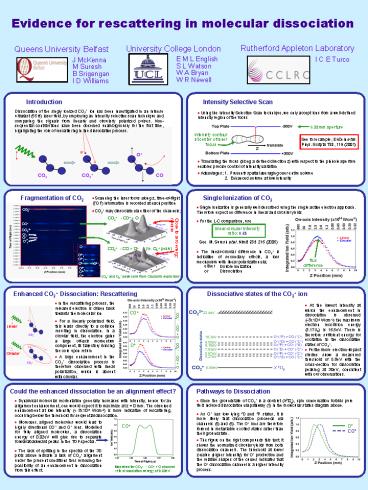Evidence for rescattering in molecular dissociation - PowerPoint PPT Presentation
1 / 1
Title:
Evidence for rescattering in molecular dissociation
Description:
Using the Intensity Selective Scan technique, we only accept ions from a well ... The observed enhancement at low intensity ( 8x1014 Wcm-2) is more indicative of ... – PowerPoint PPT presentation
Number of Views:15
Avg rating:3.0/5.0
Title: Evidence for rescattering in molecular dissociation
1
Evidence for rescattering in molecular
dissociation
Queens University Belfast
University College London
Rutherford Appleton Laboratory
E M L English S L Watson W A Bryan W R Newell
J McKenna M Suresh B Srigengan I D Williams
I C E Turco
Intensity Selective Scan
Introduction
Dissociation of the singly ionized CO2 ion has
been investigated in an intense ultrafast (55 fs)
laser field, by employing an intensity selective
scan technique and comparing the signals from
linearly and circularly polarized pulses.
Non-sequential contributions have been observed
unambiguously for the first time, highlighting
the role of rescattering in the dissociative
process.
? Using the Intensity Selective Scan technique,
we only accept ions from a well-defined intensity
region of the focus
0.25mm aperture
intensity contour at center of laser focus
See for example El-Zein et al.
Phys. Scripta T92, 119 (2001)
Z
? Translating the focus (along a defined
direction z) with respect to the pinhole aperture
enables precise control of intensity variation
? Advantages 1. Prevents spatial averaging over
entire volume
2. Enhanced volume at low intensity
Single Ionization of CO2
Fragmentation of CO2
? Scanning the laser focus along z,
time-of-flight (TOF) information is recorded at
each position
? Single ionization is generally well described
using the single active electron approach.
Therefore expect no difference in linear and
circular yields
CO2
? CO2 may dissociate via either of the channels
CO2 ? CO O
? For the L-C comparison, use
CO
linear-circular intensity ratio 0.65
CO22
Ob
Om
Of
See M. Suresh et al. NimB 235 216 (2005)
Close to zero energy release
C
CO2 ? CO O (ie. OD peak)
? The linear-circular difference in CO2 is
indicative of secondary effects, a loss mechanism
with linear polarization via
O2b
O2f
flux difference
C2
O3b
Double ionization
either
O3f
Dissociation
or
C3
C4
(OF and OB peaks are from Coulomb explosion)
Enhanced CO2 Dissociation Rescattering
Dissociative states of the CO2 ion
? In the rescattering process, the released
electron is driven back towards the molecular ion
? At the lowest intensity at which the
enhancement in dissociation is observed (8x1013
Wcm-2) the maximum electron recollision energy
(3.17UP) is 16.5eV. There is therefore sufficient
energy for excitation to the dissociative states
of CO2.
CO
? For a linearly polarized field, this leads
directly to a collision resulting in
dissociation. In a circular field, the electron
gains a large off-axis momentum component, its
trajectory missing the core upon return
Linear
CO2 ? CO O
O
? Furthermore electron-impact studies show a
measured threshold of 5.8eV with the
cross-section for dissociation peaking at 30eV,
consistent with our observations.
Circular
? A large enhancement in the CO2 dissociation
process is therefore observed with linear
polarization, which is absent with circular.
CO2 ? CO O
Could the enhanced dissociation be an alignment
effect?
Pathways to Dissociation
? Dynamical molecular reorientation generally
increases with intensity, hence for an alignment
enhancement, one would expect it to maximize at z
0 mm. The observed enhancement at low intensity
(lt 8x1014 Wcm-2) is more indicative of
rescattering, occurring below the threshold for
sequential dissociation.
? Since the groundstate of CO2 is a doublet
(X2?g), spin conservation forbids pure field
induced dissociation via pathway (1) in the
molecular states diagram above.
? As O has low lying 2D and 2P states, it is
more likely that dissociation proceeds via
channels (5) and (6). The O ions are therefore
formed in metastable excited states rather than
their groundstate.
? Moreover, aligned molecules would lead to
highly directional CO and O ions. Modelled for
fully aligned molecules, a dissociation energy of
0.02eV will give rise to separate
forward/backward peaks in the TOF spectra.
O
CO
CO
? The figure on the right compounds this fact. It
shows the normalized circular yields from both
dissociation channels. The threshold at lower
z-value (higher intensity) for O production and
the relative shapes of the curves indicates that
the O dissociation channel is a higher intensity
process.
? The lack of splitting in the spectra of the 3D
plots above indicate a lack of CO2 alignment
under the present conditions thus removing the
possibility of an enhancement in dissociation
from this effect.
Modelled for CO2 ? CO O channel with
dissociation energy of 0.02eV































